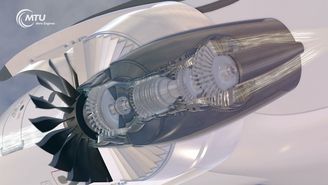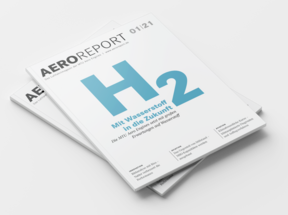
Geothermal energy
MTU wants to use deep geothermal energy as a source of energy at its site in Munich-Allach. The goal of our company climate action strategy is to reduce our carbon footprint. As a sustainable energy source, geothermal energy is an important component of our climate strategy at this location. Based on preliminary studies, we assume that we could cover about 80 percent of our heating requirements on-site with thermal water. This page explains how geothermal energy works and what we already know about the geothermal deposit in Allach.
Current status:
Drilling for deep geothermal energy
Drill path 1: 2.650 meter
Drill path 2: 160 meter
Project diary
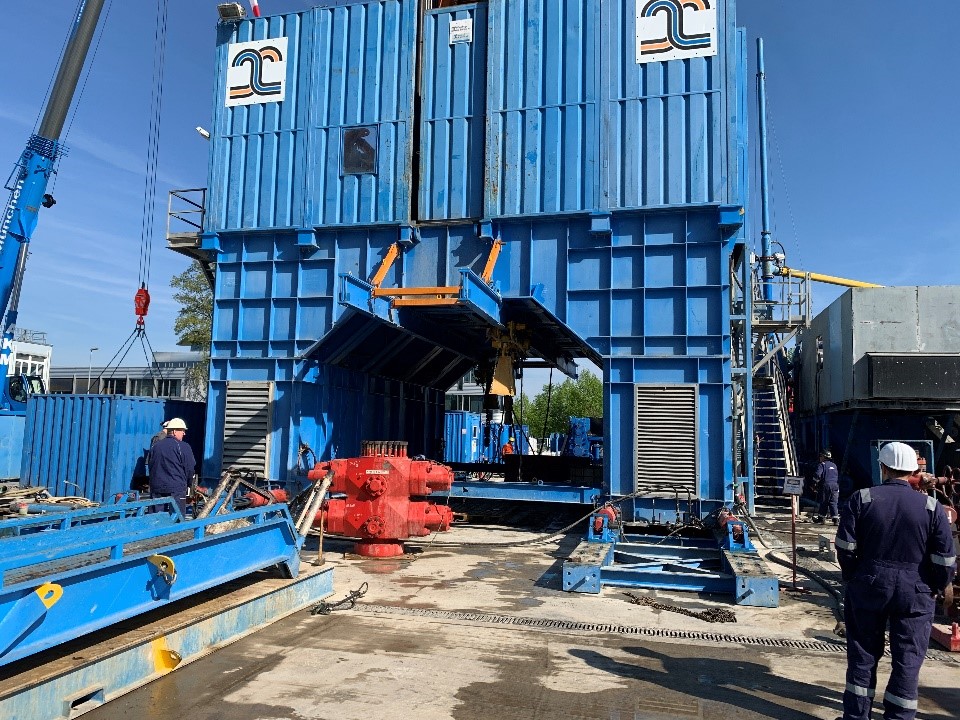
Start of second drilling path
Munich, April 19, 2024 - Last weekend, the 500-tonne drilling rig, already equipped with the drilling equipment, was successfully moved. Four hydraulic jacks were used to move the derrick from the first well to the second drilling location seven meters away. MTU started drilling the second path this week. The drilling path has a north-facing deflection. The planned drilling length is up to 3,100 meters.
.
Important stage reached - successful drilling
Munich, April 9, 2024 - "It was a significant event when we were able to pump water to the surface from a depth of around two kilometers in the first attempt at the end of March," reports project manager Stefan Lange. "We were all very tense after the intensive and careful preparations to see whether we would find what we expected down there." MTU used the pumping tests to test the yield of the borehole via the amount of thermal water. The excitement quickly gave way to joy with the first steam: "The team is thrilled at how much water could be pumped without lowering the water level too much." The data obtained so far indicates a very productive borehole, with a very good flow rate of well over 100 liters per second and a temperature of around 70°C.
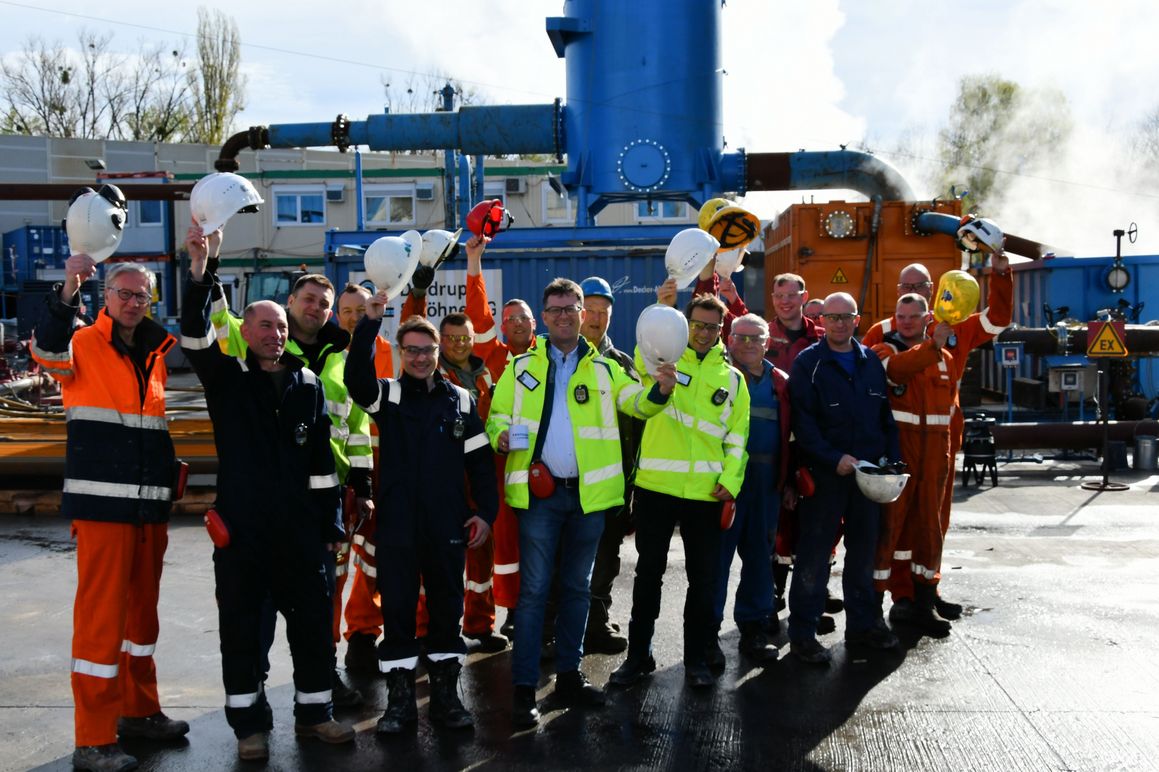
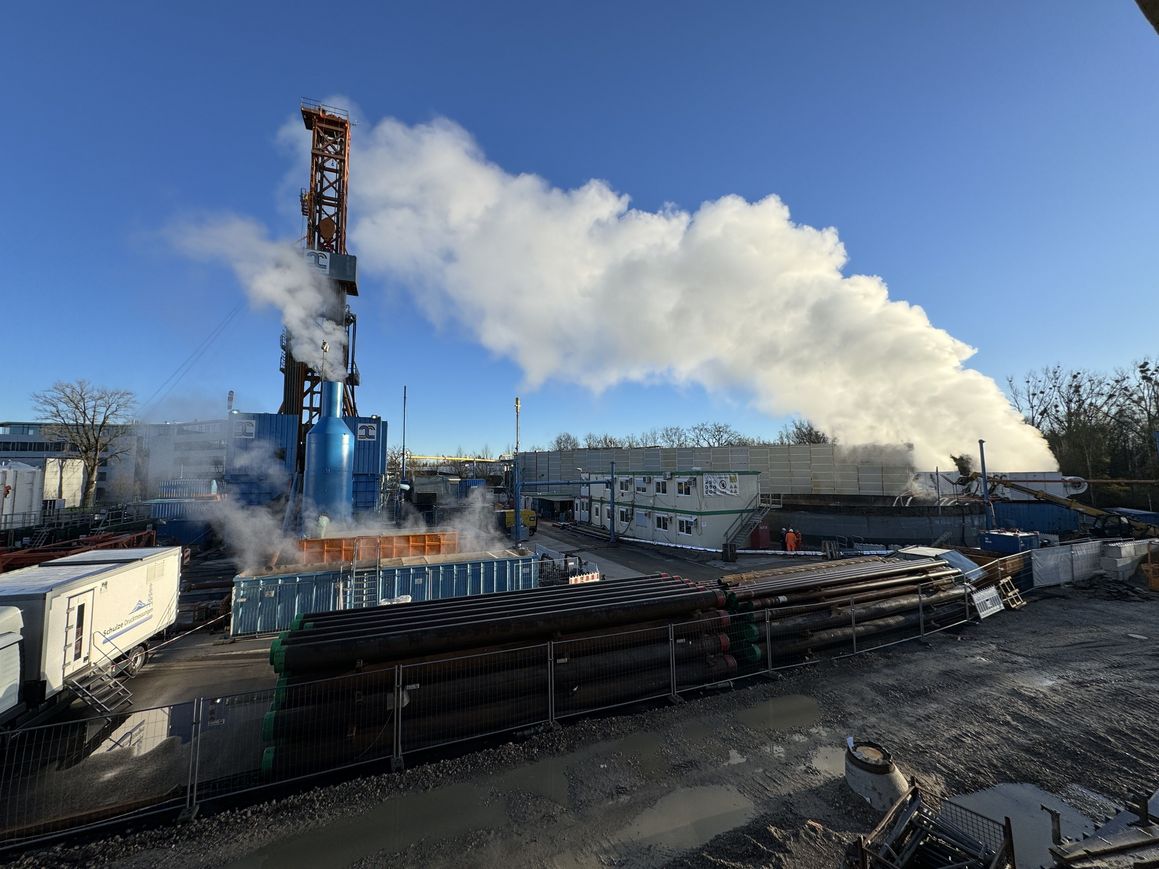
Steam cloud over MTU
Munich, March 28, 2024 - Steam is currently visible above MTU's geothermal construction site in Munich. The thermal water is currently being pumped up to determine how much water is available in the reservoir. This water must be cooled before it can be discharged into the sewer system. It is cooled down to 35 degrees for discharge into the sewage system. The cooling process produces pure water vapor. During the pumping tests, clouds of steam will continue to form at the site until April 7.
.
Harbingers of the thermal water
Munich, March 18, 2024 - Drilling work on the fourth drilling section is currently underway at a depth of over two kilometers. "We have already reached the thermal water reservoir with a pipe length of 2,600 meters," says project manager Stefan Lange. There are already initial indications of good hydraulic permeability in the drilled limestone and dolomite. "The rock at this depth is highly permeable and completely absorbs the drilling fluid that is added." A good starting point for future production. Once the drilling work for this section has been completed, geophysical borehole measurements and several pumping tests (production settlement work) will follow to determine the reservoir's yield. MTU expects hot thermal water vapor to escape during these tests.
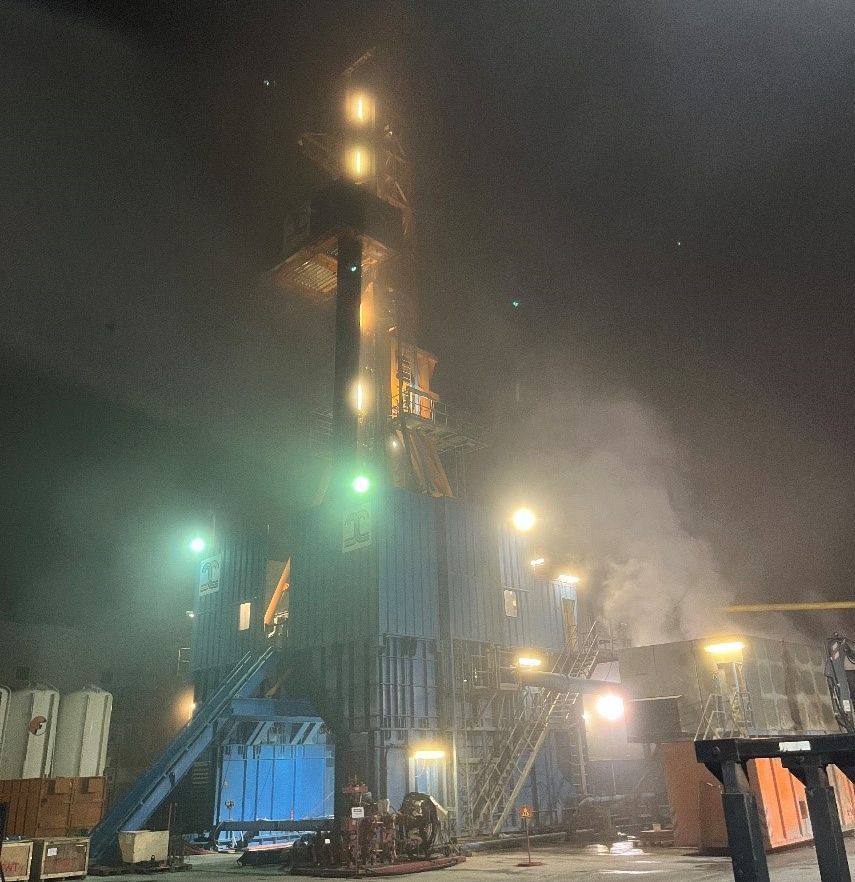
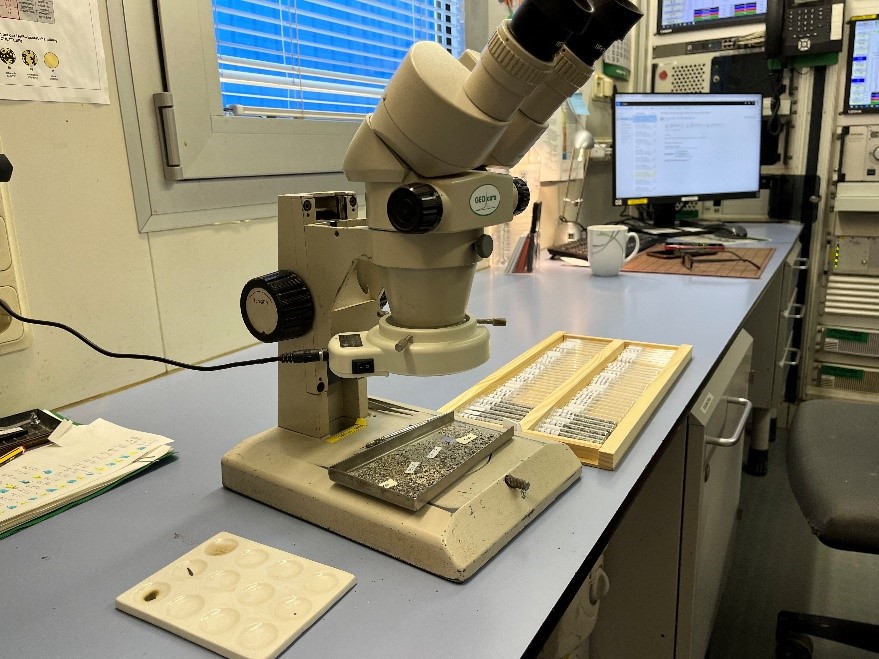
A journey into the past
Munich, March 13, 2024 - The deep geothermal borehole is a journey into the geological past: in the uppermost drilling section, the first 24 meters consist of meltwater gravel from the last ice age (Würm glacial period), several tens of thousands of years old. Below this are molasse rocks, more than 10 million years old. This is followed by sediment layers that were in the transition zone between the sea and the coastline for a long time and contain coal from swamp forests and alluvial wood from coastal forests. The 38-million-year-old molasse rocks end at a depth of around 1,700 meters. Immediately below this are limestones from the Upper Jurassic period (around 145-150 million years old). The borehole currently reaches into the Jurassic limestones ("Malm") at 2000 meters, which form the thermal water reservoir. In the past there was a shallow shelf sea in which limestone formed in a subtropical climate. The thermal water is located in the small cavities in this limestone.
Second section: Drilled and secured to a depth of more than 1.5 kilometers
Munich, February 26, 2024 - After 23 days, MTU has reached the target depth of the second drilling section at around 1,500 metres. The borehole has a diameter of 44.5 centimetres and was drilled to the south at a maximum inclination of 43 degrees using an automated underground directional drilling system. During automated directional drilling, hydraulic flaps mounted directly behind the bit push the borehole in the desired direction. The drilling fluid plays an important role: it serves as a data conduit for the exchange of information between the measuring and directional drilling equipment on the drill string at depth and the engineers on the surface. The second drilling section was secured with steel pipes: They were firmly cemented into the lower, formerly freshly drilled section, after which the casing was extended to the surface. With the start of the third drilling section, MTU has already reached 1700 metres.
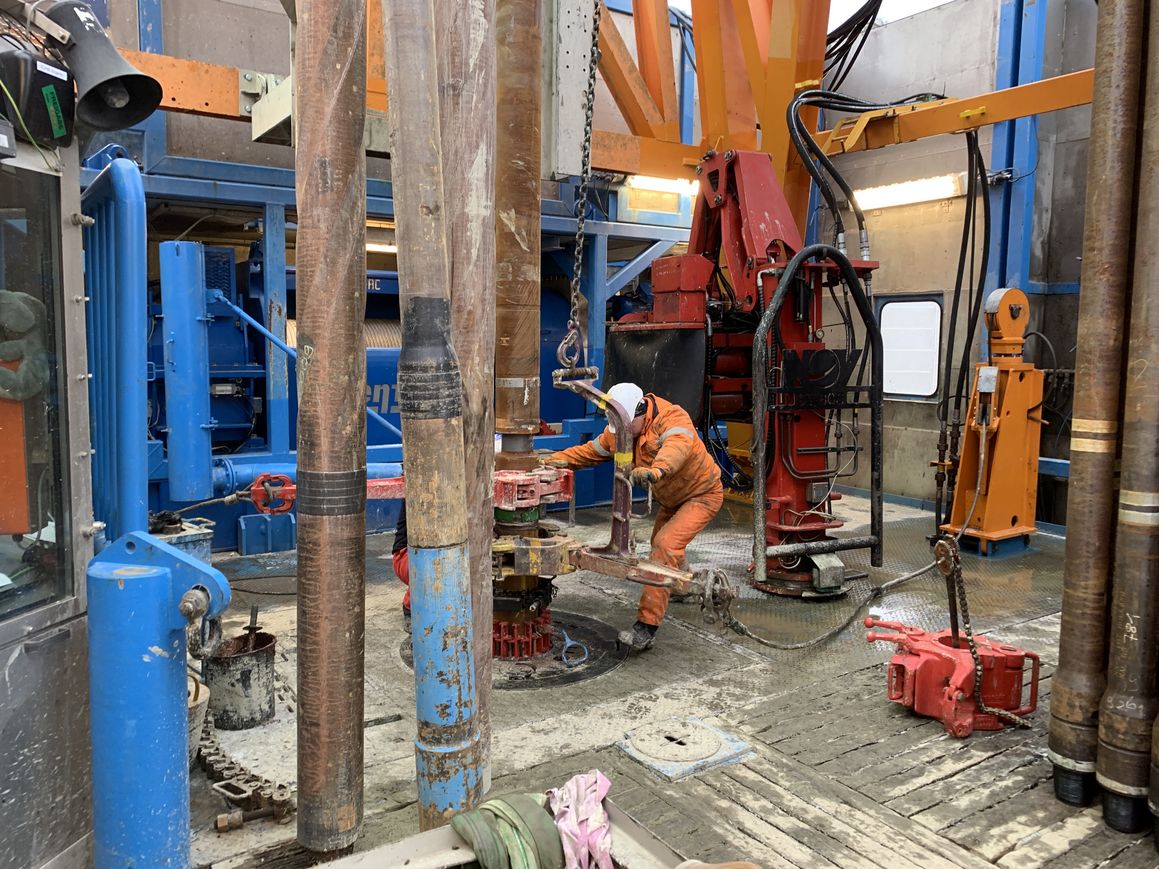
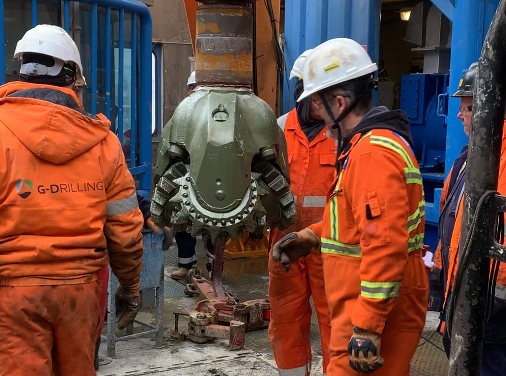
Already drilled one kilometer deep
Munich, February 12, 2024 - After ten days of drilling, the target depth of the first drilling section was reached at a depth of around 820 meters on February 1st. The borehole in this drilling section has a diameter of 66 centimetres and was drilled with a slight inclination of around 2-3 degrees to the south. To secure this first drilling section, steel pipes were installed in the following days and then firmly cemented in place.
The second drilling section is currently underway and the drilling depth is over one kilometer. The second section extends to a depth of around 1,500 meters. It is being continued with a smaller drilling diameter of around 44.5 centimetres and a more south-facing deflection.
Karl 1 and 2 seismological stations
The Karl 1 and 2 seismological stations in Karlsfeld have been in operation for MTU since October 2023. Together with a seismometer in Unterschleissheim, they cover the Karlsfeld East area More Information
Seismic monitoring plays a crucial role in the safety of geothermal plants. This technology permits real-time monitoring of vibrations in the ground. The seismic data collected also helps MTU safeguard the ongoing operation of the geothermal plant. The recorded data documents the ground vibration velocity. The data can also be used to determine the exact location of the source of the vibration.
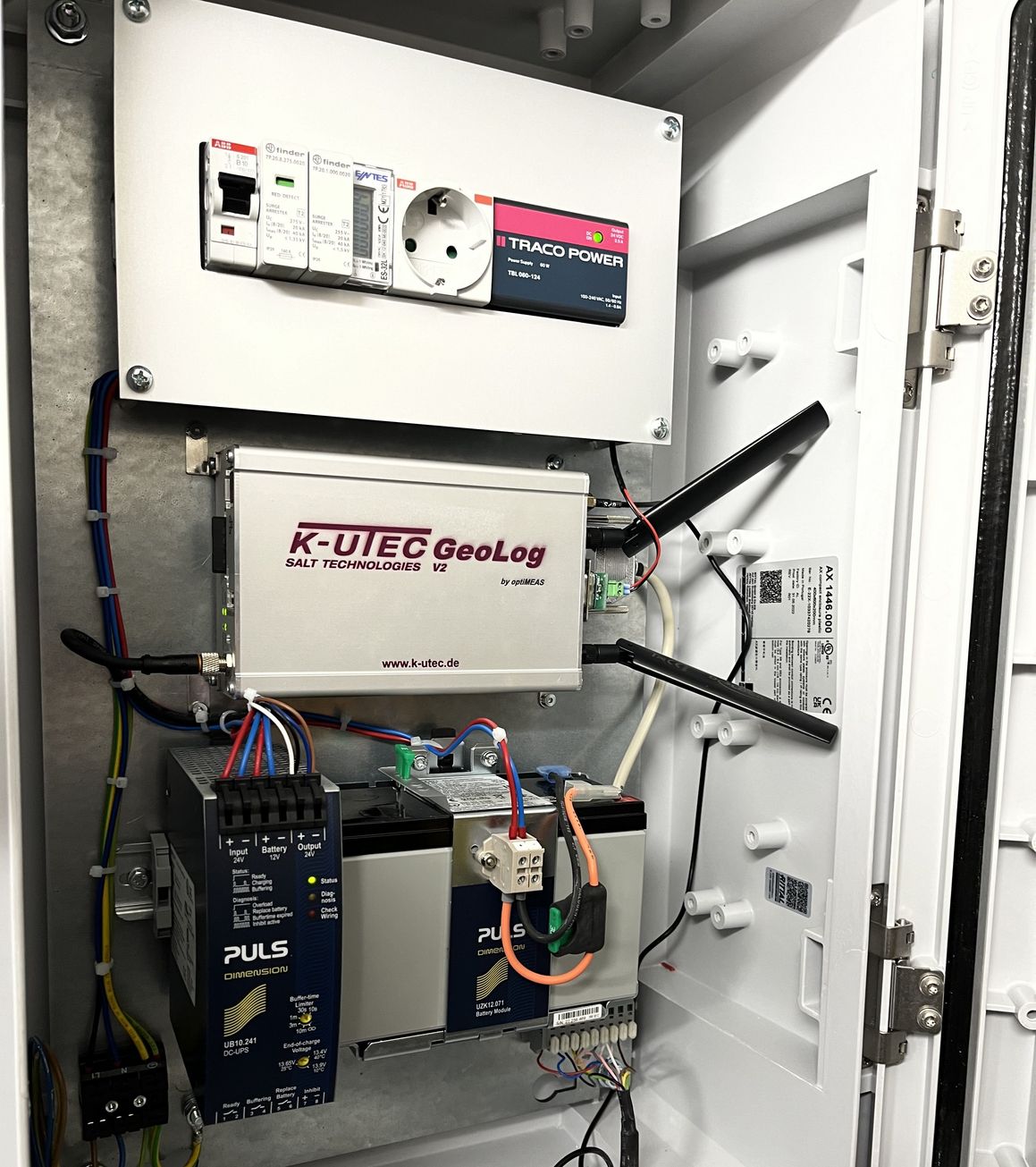
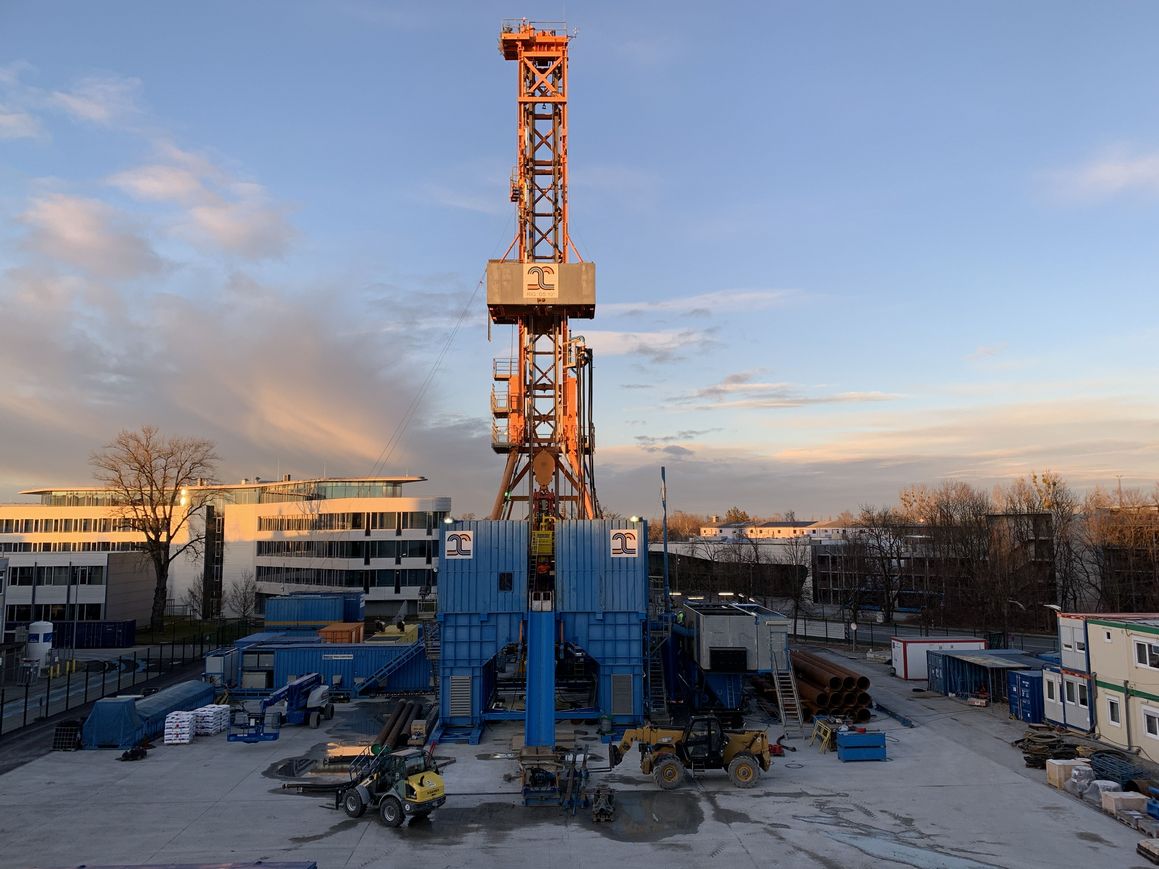
MTU starts drilling for deep geothermal energy
Thermal water some two kilometers underground is set to largely replace MTU’s current gas-based heat supply
Munich, January 11, 2024 – MTU has begun drilling work in the northeastern corner of its Munich site, close to Dachauer Strasse. Following the traditional miners’ blessing from a local priest at the beginning of December and the safety inspections and performance tests, the actual drilling can now commence.
During drilling work, different signal tones will sound, water vapor will be released, and flames will appear as any escaping gas is flared. None of this poses any danger.
Traditional miners’ blessing
Munich, December 4, 2023 – On a freezing cold St. Barbara’s Day - St. Barbara being the patron saint of miners - MTU’s geothermal team, site management, representatives of the local authorities, the company works council, and guests from the supporting MTU divisions gathered by the geothermal drilling rig erected last week to witness a local priest bless the drill bit. “Here where we stand, you can see how we as a company are tackling climate change with regard to our infrastructure,” said Dr. Markus Zeis, Senior Vice President Enablement. “We’ve spent the past three years working on this geothermal project, which affirms our commitment to Munich as a location.” Geothermal energy is the biggest step on the way to making the site climate-neutral. The energy will be used to supply the site with emissions-free heat.
How geothermal energy is working
What is geothermal energy?
Geothermal energy is the heat available below the Earth’s surface in layers of earth and rock. Geothermal energy is unimaginably abundant; for instance, as the engine for plate tectonics, it is responsible for the migration of the continents and the formation of huge mountains and volcanoes. About 99 percent of the material that makes up the Earth’s mass is hotter than 1,000 degrees Celsius. It is assumed that temperatures at the Earth’s core are over 5,000 degrees Celsius. Only in the uppermost three kilometers or so are temperatures below 100 degrees Celsius. The temperature in the Earth’s crust increases by an average of about 3 degrees Celsius per 100 meters of depth.
How does geothermal energy work?
There are different types of geothermal energy and technologies for harnessing it. The process MTU is looking to use in Munich(Allach) is hydrothermal geothermal energy. From a depth of around 2,200 meters, a production well will pump hot water at a temperature of around 70–75 degrees Celsius from a deep groundwater reservoir up to the surface. In a closed thermal water circuit, the heat can be transferred via heat exchangers to MTU’s heating water circuit, causing the water temperature to drop to about 40 degrees. The cooled water will be returned via an injection well to the same deep groundwater reservoir from which it was drawn. There, it will heat up again, and the cycle will begin anew.
Why does MTU want to use geothermal energy?
The use of geothermal energy is part of MTU’s climate strategy. MTU has operated its site on a carbon-neutral basis since the end of 2021. We achieve this by offsetting unavoidable emissions. The goal of our climate strategy is to reduce emissions by 60 percent by 2030 (compared to 2019 levels). The use of geothermal energy for heating is a crucial step in this process, because it is a carbon-free energy source. Using the thermal water directly means the efficiency is very high. Only the thermal water pump and the circulation pumps require electrical energy. In addition, compared with conventional energy supplies, this approach eliminates transport routes and storage because the energy source is located directly under the MTU facility.
Where are MTU’s geothermal wells located?
The drilling site is located in the northeastern area of the MTU premises, close to Dachauer Strasse
What path do the boreholes take?
There are two bore paths. Both wells will start from a common drilling site (known as a drilling pad). There, they are only a few meters apart. With increasing depth, the horizontal distance between the two wells will stretch to more than 2,000 meters. The production well runs in a southerly direction, the injection well in a northerly direction. Each will be about three kilometers long. In total, about six kilometers of drilling pipelines will be used.
How is the hot water used?
Once the thermal water has released its heat into the MTU location’s heating circuit via a heat exchanger, all the location’s buildings can essentially be supplied with heat.
What is the Molasse Basin?
The Molasse Basin is the geological name for the region between the Danube and the Alps. As a result of the uplift and overthrust of Alpine nappes onto the European crust, the weight of the mountains developing on top of the underlying crust pushed it several kilometers downward into the Earth’s mantle. At the same time as the Earth’s crust was sinking, the basin this formed steadily filled up again with debris eroded from the Alps. This geological basin is called the Molasse Basin. At the base of this basin is a water-bearing limestone layer (the Malm karst), which was formerly at the Earth’s surface, but is now encountered at varying depths, depending on the location. By the Danube south of Regensburg, it lies only a few meters deep; on the edge of the Alps, the Molasse Basin is already over 5,000 meters deep. In the Munich area, it is located at a depth of 2,000 to 3,000 meters.
What is the Malm karst?
At the base of the Molasse Basin, the Malm karst forms a deep karst aquifer approximately 500 to 600 meters thick. As a geothermal energy source directly beneath MTU’s Munich location, the company can use this aquifer to supply heat. The characteristics of the Malm karst mean water can circulate well in its pores, fissures and karst cavities and absorb heat from the environment, making it an ideal hydrothermal reservoir. The Malm limestone dates from the Upper Jurassic period and is about 150 million years old. At that time, southern Bavaria was a subtropical shallow sea with reefs and lagoons. The thermal water from the Malm karst is used directly, for example, in spas located in Erding, near Munich, and in Lower Bavaria, Upper Austria and Upper Swabia.
Are there environmental risks associated with building or operating a geothermal system?
In principle, the environmental risks associated with deep geothermal energy are very low. The water is returned to the reservoir without further modification once its heat has been transferred to the heat exchanger. In Germany, the requirements and official specifications for the protection of the environment during the construction and operation of a geothermal plant are very high and are monitored intensively. The geological conditions of the deep subsurface in the Munich area are already thoroughly understood from numerous geothermal boreholes or from former deep wells for oil and gas. This means that in the Molasse Basin, drilling challenges arising from geologic uncertainties can be very well defined. The wells will be drilled in such a way that by means of several telescopically interlocked and concreted-in steel pipes, the boreholes are secured in a stable manner for the long term. This technique prevents the inflow of water or gas from the various strata through which the wells pass. During the drilling process, only substances will be used for which a risk to drinking water can be ruled out. Rocks from the wells, the water brought to the surface and the gases dissolved in it will be regularly tested for their composition during the drilling phase.
At the drilling site, additional structural measures are in place to prevent contamination of the soil even in the event of an accident (e.g. tank leakage). This includes a concrete surface with an appropriate drainage design, temporary storage tanks, inspection chambers and oil separators. The thermal water from the Malm itself is characterized by its low content of dissolved substances. Traces of oil or gas can sometimes be found in some geological strata or even in the Malm water. For this reason, the deep water will be routed in a closed system from extraction through heat exchange to recirculation. This will prevent the escape of any gases or substances that may be hazardous to the environment.
Is geothermal energy consistently available?
Geothermal energy is always available. Unlike other sustainable and carbon-free energy sources, its use is not dependent on time of day, weather or climate.
Is the geothermal plant large?
A geothermal plant is not particularly large. MTU already has a combined heat and power plant on-site at its Munich location, so the geothermal system only needs to be integrated into the existing heat distribution system. The main part of the geothermal plant is located out of sight under the ground. Above ground, only the well heads, two compact pipelines and the heat transfer station are visible.
Is a geothermal system noisy?
The thermal water borehole pump installed for continuous operation hangs at a depth of several hundred meters and cannot be heard at the surface. The network pumps, heat exchangers and power supply are housed in a small building and are also not a source of noise for the surrounding area.
Only during the construction and drilling phases will there be a perceptible level of noise at times; examples include individual components of the drilling rig such as pumps or vibrating screens, the unloading of pipes, or construction site traffic. Potential sources of noise will be enclosed when necessary. Any noisier work or truck transports will be performed during the day, if possible. The drilling process as such, i.e. the sound of the bit drilling through the rock, is neither audible nor perceptible at the Earth’s surface. In continuous operation, the geothermal plant complies with all the requirements of legally regulated noise protection.
Does the use of geothermal energy produce pollutants?
Since no combustion takes place, no exhaust gases are released when geothermal energy is used. At MTU, the thermal water will be used in a closed circuit to supply heat, so the gases or other constituents dissolved in the water will remain in the thermal water circuit. The hydrothermal heat recovery approach taken by MTU is a purely physical process.
Will the plant have an impact on the flora and fauna in the surrounding area?
Deep geothermal energy at MTU’s Munich location will have no impact on flora and fauna, as the plant will have no effect on the near-surface area. Lowering the rock temperature in deeper areas has no effect on the microclimate or the flora and fauna at the surface; this is determined by the temperature down to a depth of around 20 meters—the area where soil organisms or plant roots are found. The soil temperature here is a result of solar radiation and percolating rainwater as well as moving groundwater. This means the geothermal energy present in the shallow subsurface is predominantly stored solar energy and is subject to seasonal temperature fluctuations.
Does deep geothermal energy threaten other aquifers?
No. Detailed borehole planning and proven drilling techniques prevent mutual interference. The near-surface groundwater is already being secured with standpipes (steel pipes reaching down to a depth of about 50 meters) as part of the drilling site construction. Due to their strength and impermeability, these standpipes ensure the stability of the well. This both prevents thermal water from penetrating near-surface groundwater and ensures no groundwater enters the drilling area.
Does the thermal water carry toxic substances to the surface?
Toxic substances, such as hydrogen sulfide or traces of oil, may be present in thermal water. However, since the thermal water cycle is conducted in a closed system and the water is reintroduced into the same deep aquifers after the heat is removed, there is no contamination of the surface with potentially toxic substances. The composition of the Malm water in the Munich area is also known from numerous geothermal wells and generally raises no critical concerns. Some spas also use this water directly for filling their baths.
How long can MTU use geothermal energy as a heat source?
The heat source itself is inexhaustible by human standards. The use of geothermal energy is therefore limited only by the lifetime of the technical equipment and structures. As the water is recirculated back into the reservoir, the hydrogeological balance is maintained. The flow of heat from the Earth’s interior will not end. This means the cooled area around the injection well will also warm up again and can regenerate.
Are there hydrothermal alterations in the deep aquifer?
The thermal water used for MTU’s geothermal energy is drawn from a depth of about 2,200 meters, and the cooled water is reintroduced at a comparable depth into the same geological horizon at a sufficient distance. Harnessing the water’s heat does not involve MTU extracting any substances from the water. Returning the water causes the rock to cool in the immediate vicinity of the injection well. The cooled water is reheated as it flows onward through the rock.
Is there an earthquake risk from geothermal use?
Hydrothermal exploitation in the Molasse Basin can cause microearthquakes. As a rule, this microseismicity is far below the human perception threshold. In the Bavarian Molasse Basin, the occurrence of damaging earthquakes caused by hydrothermal geothermal energy is extremely unlikely. This assessment from two decades of hydrothermal energy production is confirmed in the Bavarian Geothermal Atlas of the State Ministry of Economic Affairs, Regional Development and Energy. In order to accurately record possible microseismic events and also to be able to distinguish possible induced microearthquakes from naturally occurring or perceptible earthquakes, every geothermal project in the Munich area is now accompanied by a seismic monitoring system as standard. The operators in the Munich region have joined together to form a network and thus obtain data of very high accuracy.

